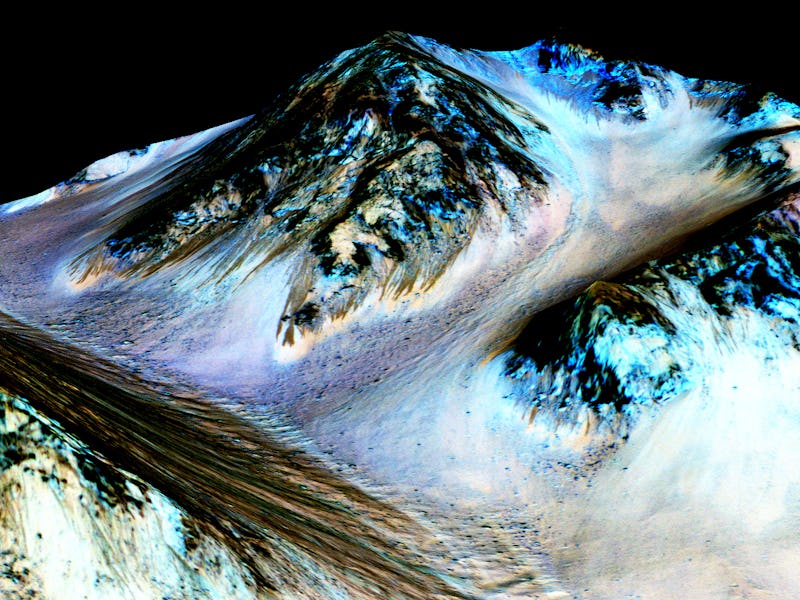NASA May Have Divined More Liquid Water on Mars
Are there aliens bumming it in any of these sites?

It’s been over ten months since NASA confirmed liquid water exists on the surface of Mars, and subsequent research is beginning to illustrate that the nature of water on the red planet is a lot more puzzling than we initially imagined. New findings suggest huge Martian canyons could contain liquid water that, unexpectedly, isn’t being warmed up beneath the surface. Naturally, the new observations complicate our understanding of the landscape (and the organism that might potentially reside there).
NASA’s announcement last September was huge, but a tiny, crucial detail got buried in that hoopla: Liquid water pockets are seasonally transient, occurring only in certain parts of the planet called recurring slope lineae. That’s a hellaciously awkward phrase to describe dark streaks that appear downslope of Martian hills and mountainous regions during warmer seasons.
So we thought anyway.
A new study published Thursday in the Journal of Geophysical Research: Planets disrupts this idea. In studying images of the Valles Mariners region near the Martian equator, researchers noticed that RSL were forming in isolated peaks and ridges that were very unlikely to result from underground deposits of water making their way to surface.
Blue dots on this map indicate sites of recurring slope lineae (RSL) in part of the Valles Marineris canyon network on Mars.
“The occurrence of recurring slope lineae in these canyons is much more widespread than previously recognized,” said the University of Arizona planetary researcher and study lead author Matthew Chojnacki in a statement. “As far as we can tell, this is the densest population of them on the planet, so if they are indeed associated with contemporary aqueous activity, that makes this canyon system an even more interesting area than it is just from the spectacular geology alone.”
Naturally, the presence of liquid water is of profound interest to those looking for signs of life, but the critical question right now isn’t who’s drinking the stuff, but where is the stuff coming from?
The answer might be salt. It’s already known that the RSL sites contain water that’s briny. The high salt concentrations might be strong enough to pull water vapor out of the Martian atmosphere. Not only would such a mechanism make sense, but it would strengthen the known link between RSL and salt.
Sites with Seasonal Streaks on Slopes in Mars CanyonsNumerous Seasonal 'Lineae' on Coprates Montes, MarsThe white arrows indicate locations in this scene where numerous seasonal dark streaks, called "recurring slope lineae," have been identified in the Coprates Montes area of Mars' Valles Marineris by repeated observations from orbit.
Of course, there are problems with this explanation as well. Mars is an incredibly dry planet. The amount of water vapor in the atmosphere above the Valles Marineris is higher than the planet’s average, and the RSL sites in this region seem to collect enough water to fill about 10 to 40 Olympic-size swimming pools. But the researchers don’t know if the RSL sites have a process that’s efficient enough to extract that much water that pools up at those locations.
“There do seem to be more ways atmosphere and surface interact in the canyons than in blander topography, such as clouds trailing out of the canyons and low-lying haze in the canyons,” said Chojnacki. “Perhaps the atmosphere-surface interactions in this region are associated with the high abundance of recurring slope lineae. We can’t rule that out, but a mechanism to make the connection is far from clear.”
As always, the only way to solve this mystery is to collect more data — ideally through direct observations. There are quite a few projects in the pipeline for future Martian observations, but until we’re able to gather that data, the water-on-Mars plot continues to thicken.